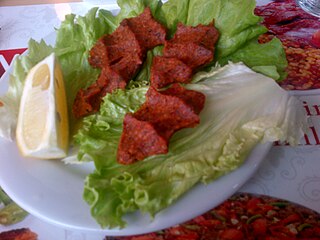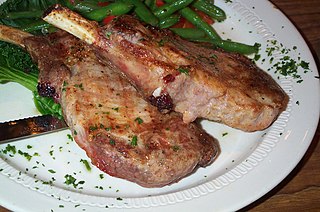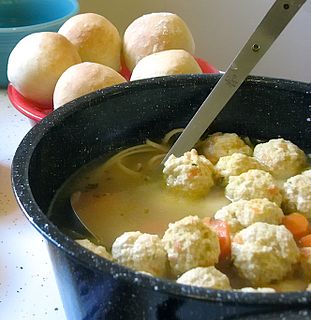
Turkish cuisine is largely the heritage of Ottoman cuisine, which can be described as a fusion and refinement of Central Asian, Middle Eastern, Mediterranean, Eastern European and Balkan cuisines. Turkish cuisine has in turn influenced those and other neighbouring cuisines, including those of Southeast Europe (Balkans), Central Europe, and Western Europe. The Ottomans fused various culinary traditions of their realm with influences from Levantine cuisines, Egyptian cuisine, Greek cuisine, Balkan cuisine, along with traditional Turkic elements from Central Asia, creating a vast array of specialities.

Offal, also called variety meats, pluck or organ meats, is the viscera and entrails of a butchered animal. As an English mass noun, the term "offal" has no plural form. The word does not refer to a particular list of edible organs, which varies by culture and region, but includes most internal organs and excludes muscle and bone. Offal may also refer to the by-products of milled grains, such as corn or wheat.

Meatloaf is a dish of ground meat that has been combined with other ingredients and formed into the shape of a loaf, then baked or smoked. The final shape is either hand-formed on a baking tray or pan-formed by cooking it in a loaf pan. It is usually made with ground beef, although ground lamb, pork, veal, venison, poultry and seafood are also used, sometimes in combination. Vegetarian adaptations may use imitation meat or pulses.
Romanian cuisine is a diverse blend of different dishes from several traditions with which it has come into contact, but it also maintains its own character. It has been mainly influenced by Turkish and a series of European cuisines in particular from the Balkans, or Hungarian cuisine as well as culinary elements stemming from the cuisines of the Slavic-speaking countries of Eastern and Central Europe.

Bulgarian cuisine is a representative of the Mediterranean cuisine of Southeast Europe. It shares characteristics with other Balkan cuisines. Bulgarian cooking traditions are diverse because of geographical factors such as climatic conditions suitable for a variety of vegetables, herbs and fruit. Aside from the vast variety of local Bulgarian dishes.

Kofta is a family of meatball or meatloaf dishes found in the Indian subcontinent, South Caucasian, Middle Eastern, Balkan, and Central Asian cuisines. In the simplest form, koftas consist of balls of ground meat - usually beef, chicken, lamb or mutton, pork, or a mixture - mixed with spices or onions. In Muslim areas, pork is not used, and in India, beef is not used. In Greece and Cyprus, vegetarian versions are known as hortokeftedes, and often eaten during fasting periods such as Lent. An uncooked version is also made in Turkey, called çiğ köfte. In India, vegetarian varieties may use potato, calabash, paneer, or banana. In Europe, kofta is often served in a fast-food sandwich in kebab shops.

Levantine cuisine is the traditional cuisine of the Levant, known in Arabic as the Bilad al-Sham and Mashriq, which covers a large area of the Eastern Mediterranean. It continues to carry an influentially mainstream character in a majority of the dishes today. It is found in the modern states of Cyprus, Jordan, Lebanon, Israel, Palestine, Syria, and parts of southern Turkey near Adana, Gaziantep, and Antakya. Conversely, some of the dishes listed below may have early origins in neighboring regions, but have long since become traditions in the Levant.

Barbecue varies by the type of meat, sauce, rub, or other flavorings used, the point in barbecuing at which they are added, the role smoke plays, the equipment and fuel used, cooking temperature, and cooking time.

Sheftalia (locally [ʃeftaˈʎa]; Greek: σιεφταλιά; Turkish: şeftali kebabı or şeftali; is a traditional Cypriot food. It is a type of crépinette, a sausage without skin, that uses caul fat, or omentum, the membrane that surrounds the stomach of pig or lamb, to wrap the ingredients rather than sausage casing. It is a traditional Cypriot dish.

Çiğ köfte or chee kofta is a köfte dish in Armenian, Kurdish and Turkish cuisines and very similar to kibbeh nayyeh and to a lesser extent to steak tartare. It is traditionally made with either raw beef or lamb, but in Turkish restaurants and fast food spots only the vegetarian variety made with extra fine bulgur may be served.

Many regional cuisines feature a mixed grill, a meal consisting of a traditional assortment of grilled meats.

A meat chop is a cut of meat cut perpendicular to the spine, and usually containing a rib or riblet part of a vertebra and served as an individual portion. The most common kinds of meat chops are pork and lamb. A thin boneless chop, or one with only the rib bone, may be called a cutlet, though the difference is not always clear. The term "chop" is not usually used for beef, but a T-bone steak is essentially a loin chop, a rib steak and a rib cutlet.

The liver of mammals, fowl, and fish is commonly eaten as food by humans. Domestic pig, lamb, calf, ox, chicken, goose, and cod livers are widely available from butchers and supermarkets while stingray and burbot livers are common in some European countries. Animal livers are rich in iron, copper, the B vitamins and preformed vitamin A. It is unsure if daily consumption of liver can be harmful, as no conclusive research has been done on the toxicity of preformed vitamin A from food. A single serving of beef liver exceeds the tolerable upper intake level of vitamin A. 100 g cod liver contains 5 mg of vitamin A and 100 µg of vitamin D.

Faggots are meatballs made from minced off-cuts and offal, especially pork together with herbs for flavouring and sometimes added bread crumbs. It is a traditional dish in the United Kingdom, especially South and Mid Wales and the English Midlands.

A meatball is ground meat rolled into a small ball, sometimes along with other ingredients, such as bread crumbs, minced onion, eggs, butter, and seasoning. Meatballs are cooked by frying, baking, steaming, or braising in sauce. There are many types of meatballs using different types of meats and spices. The term is sometimes extended to meatless versions based on vegetables or fish; the latter are commonly known as fishballs.

Street foods, ready-to-eat food or drink sold in a street or other public place, such as a market or fair, by a hawker or vendor, often from a portable stall, have variations within both regions and cultures. For example, Dorling Kindersley describes the street food of Viet Nam as being "fresh and lighter than many of the cuisines in the area" and "draw[ing] heavily on herbs, chile peppers and lime," while street food of Thailand is "fiery" and "pungent with shrimp paste... and fish sauce" with New York City's signature street food being the hot dog, although the offerings in New York also range from "spicy Middle Eastern falafel or Jamaican jerk chicken to Belgian waffles." In Hawaii, the local street food tradition of "Plate Lunch" was inspired by the bento of the Japanese who had been brought to Hawaii as plantation workers.

A steak is a meat generally sliced across the muscle fibers, potentially including a bone. It is normally grilled, though can also be pan-fried. It is often grilled in an attempt to replicate the flavor of steak cooked over the glowing coals of an open fire. Steak can also be cooked in sauce, such as in steak and kidney pie, or minced and formed into patties, such as hamburgers.

Ground meat, called mince or minced meat outside of North America, and keema or qeema in the Indian subcontinent, is meat finely chopped by a meat grinder or a chopping knife. A common type of ground meat is ground beef, but many other types of meats are prepared in a similar fashion, including pork, lamb, and poultry. In the Indian subcontinent, both mutton and goat meat are also minced to produce keema.
















